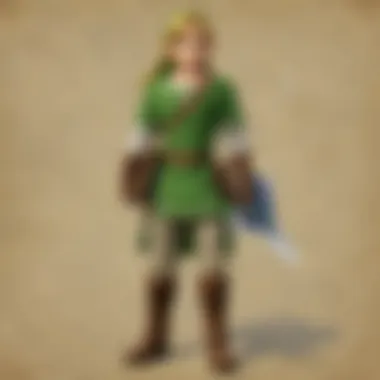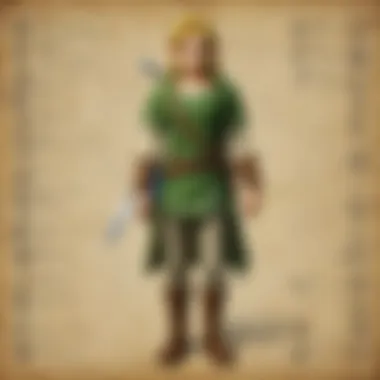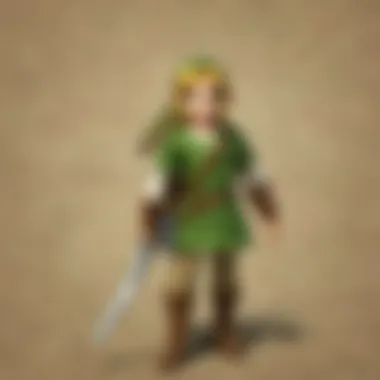Understanding Link Theory in Zelda: A Comprehensive Analysis


Intro
The Zelda franchise has captivated audiences since its inception, weaving together intricate narratives, memorable characters, and dynamic gameplay. At the core of this engagement lies the concept of Link Theory. This theory posits that there are deep and interrelated connections between the various facets of the franchise, including character arcs, storylines, and gameplay mechanics. In this article, we will thoroughly investigate these connections, providing insight into how Link Theory enhances the overall gaming experience for both new players and long-time fans.
Understanding Link Theory not only requires a look at individual elements but also conversations around overarching themes and motivations. By dissecting these components, we aim to reveal the depth and complexity that enriches the Zelda series. Throughout the article, we will examine gameplay features, character development, lore, and practical gameplay strategies, each contributing to a comprehensive understanding of Link Theory.
Prelude to Link Theory
The examination of Link Theory is integral to understanding the depth of the Zelda franchise. This theory serves as a foundation for analyzing character relationships, narrative structures, and gameplay mechanics. By exploring these connections, players can gain a richer appreciation of the series. Link Theory transcends mere gameplay, delving into the motivations behind characters and the significance of their journeys.
By focusing on Link and Zelda's intertwined fates, one can unravel the thematic layers that define the series. This exploration not only benefits fans but also stimulates academic discussions around game narrative and design.
Definition of Link Theory
Link Theory can be defined as a framework for understanding the relationships between characters, narratives, and gameplay in the Legend of Zelda series. It explores the dynamics that connect Link, Zelda, and various other characters throughout the games. This theory considers how these connections shape the overarching story and influence the player's experience. By analyzing Link Theory, one can identify recurring motifs, narrative resolutions, and the evolution of character arcs across different titles. These insights contribute to a comprehensive understanding of the Zelda franchise as a cohesive and interrelated universe.
Historical Context of the Theory
The historical context of Link Theory encapsulates the evolution of the Zelda series from its inception in 1986 to the contemporary titles. Originally, the games were designed as independent experiences. However, as the franchise developed, a deeper narrative continuity emerged. Each game introduced new elements while referencing previous titles, creating a complex web of stories that form the foundation of Link Theory.
Over time, fans began to recognize patterns in storytelling and character development, prompting analysis that would later be formalized into Link Theory. The rich lore, characterized by mythological influences and cyclical themes, further enhanced the desire to articulate these connections. Today, scholars and fans alike explore Link Theory not just for enjoyment, but to gain insights about game design and narrative engagement in video games. The interaction between gameplay and story within Link Theory remains critical for understanding the franchise's lasting impact.
The Foundations of Link Theory
The study of Link Theory serves as a cornerstone for understanding the Zelda franchise. This theory provides an analytical framework through which players can interpret the intricate relationships between characters, narratives, and game mechanics. Delving into Link Theory reveals several essential aspects: character arcs, narrative themes, and gameplay elements that intertwine to create a compelling player experience. Establishing a foundation in Link Theory enhances our understanding of the franchise's enduring popularity and its impact on gaming culture. By grasping these foundations, players can appreciate not just the story but also the design choices behind each game.
Key Concepts and Principles
Key concepts and principles of Link Theory include recurring themes, narrative structure, and character dynamics. At its core, the theory emphasizes the connections between Link, Zelda, and Ganon. These characters often embody the classic archetypes of hero, princess, and villain. Each iteration of the game series revisits this trio, presenting them in various forms, yet maintaining their core identities. This cyclical representation of characters resonates with players, reinforcing their emotional investment in the narrative.
The theory further explores how gameplay mechanics support the storytelling. For example, the use of puzzles often reflects the inner struggles of the characters, and overcoming these obstacles drives the plot forward. Moreover, the world of Hyrule itself functions as a character, influencing events and shaping interactions, thus creating a rich tapestry that players navigate through.
Influence of Game Design on Theory Development
Game design significantly influences Link Theory's evolution. Early iterations of the Zelda series, such as "The Legend of Zelda" and "The Adventure of Link," laid the groundwork by introducing innovative mechanics and expanding narrative possibilities within a confined framework. As technology advanced, so did the capabilities of game designers. This allowed for deeper explorations of themes like destiny, sacrifice, and the passage of time.
Today, titles such as "Breath of the Wild" push boundaries not only in gameplay but also in narrative complexity. The open-world format encourages a non-linear approach to storytelling, resulting in varied experiences for different players. This evolution reflects in Link Theory, as the theory must adapt to these changes within the gameplay and narrative structure.
In summary, understanding the foundations of Link Theory is essential for delving into the Zelda franchise. It highlights how character relations, game mechanics, and narrative layers combine to form a cohesive and engaging experience.
Character Dynamics Within Link Theory


Understanding character dynamics is crucial in comprehending Link Theory within the Zelda franchise. These dynamics shape the narrative and contribute significantly to player experience. Each character serves a purpose, carrying motivations that resonate with players. They are not merely avatars in a game; they embody the themes and emotions that drive the story forward.
Link, as the central character, plays a dynamic role that is multifaceted. His journey reflects growth, heroism, and resilience. This makes him relatable to players, inviting them into his world. The evolution of Link across different titles illustrates how character development can mirror the challenges players endure.
Analysis of Link as a Central Figure
Link’s position as the protagonist is fundamental to the Zelda series. He is often depicted as a young hero embarking on a quest to save Hyrule and Princess Zelda. This quest often intertwines with the broader themes of courage and fate. His iconic green tunic and courageous demeanor serve not just as a visual identity but also as a representation of the player's journey.
Throughout the series, Link’s character remains consistent yet adaptable. Each iteration of Link introduces new elements while maintaining core characteristics that define his role in the narrative. Players experience the world through Link's perspective, which enhances engagement and emotional investment in his character’s quest. Overall, Link’s agency in confronting challenges drives the story, making him central to Link Theory.
Zelda's Role in the Narrative Framework
Zelda’s role is equally vital in the context of Link Theory. As a character, she represents wisdom and the lineage of Hyrule's rulers. Often, she provides the narrative motivation for Link’s actions. Her participation in the story is not limited to being a damsel in distress; she frequently plays a key role in the unfolding events, influencing outcomes significantly.
The dynamic between Link and Zelda is complex. Their relationship reflects themes of companionship, mutual respect, and shared destiny. Zelda’s characterization as a powerful figure, sometimes taking on forms such as Sheik or Tetra, demonstrates her multifaceted nature. This evolution allows her to contribute actively to the storyline, providing depth and richness to the narrative framework. Her character emphasizes the importance of teamwork and collaboration in overcoming adversity.
Supporting Characters and Their Impact
Supporting characters in the Zelda franchise enrich the story and enhance Link's journey. Figures such as Navi, Tingle, and the various sages provide guidance, companionship, and, at times, comic relief. Each of these characters contributes to the game's overall theme, reinforcing the values of friendship and loyalty.
Moreover, these characters often present unique perspectives that explore different facets of the Zelda world. They serve as conduits for lore, offering insight and background that enhance player understanding of the complexities of Hyrule's history and culture. Tingle, for instance, brings an element of humor while expanding on the lore of fairies and maps.
"The interplay of characters within Link Theory offers a unique lens through which to view the evolution of storytelling in video games."
In summary, appreciating the character dynamics within Link Theory reveals layers of meaning that enrich the Zelda experience for fans. Through intentional character development, the franchise invites exploration of deeper narratives and themes that resonate across generations.
Narrative Structures and Themes
Narrative structures and themes play a crucial role in enhancing the depth of the Zelda franchise. They shape how stories are conveyed and how players connect with characters and scenarios. Understanding these elements helps to dissect the intricate relationships between various game mechanics and narrative arcs. Themes are the fundamental ideas that resonate throughout the series, influencing character motivations and outcomes. A thorough analysis of these structures provides insights into the broader cultural and psychological implications embedded in the gameplay experience.
Mythological Influences in Zelda Narratives
The Zelda series exhibits strong mythological undercurrents, drawing inspiration from diverse cultures. This connection lends a rich texture to its storytelling. The characters and quests often echo archetypal myths. For instance, Link's journey frequently parallels the hero's journey, a narrative model identified by Joseph Campbell. This recognizes the stages of departure, initiation, and return.
Moreover, prominent elements such as the Triforce symbolize power, wisdom, and courage, resonating with mythological motifs of balance and duality. Link can be seen as a representation of the 'everyman' hero, faced with trials that echo ancient legends. These mythological influences do not merely serve as backdrops; they deepen the emotional stakes and elevate the player’s investment in the narrative.
The integration of mythical motifs assists in maintaining a timeless quality to the stories told within the games. When players explore the world of Zelda, they engage with archetypes that echo across generations and cultures, facilitating profound player experiences.
Cyclic Nature of the Legend
A distinctive aspect of the Zelda series is its cyclic nature, where the narrative often revisits themes and characters in various iterations. This repetition fosters a unique continuity, making each game feel both new and familiar. The cyclical structure often relates to the concept of reincarnation, showcasing Link and Zelda's reincarnations as they face off against Ganon or other antagonists.
Many games in the series illustrate this cycle through lore and gameplay mechanics. For instance, the repetitive struggle between good and evil embodies not only the characters' growth but also the evolving nature of player experience. Each new title builds upon the foundation established by previous games while presenting fresh narratives.


This concept allows for infinite interpretations and speculation among fans. Some theorists argue that the cycle reflects real-life challenges people face. Link's quest represents ongoing struggles in one's life, resonating through different cultural contexts. The ability to reinterpret these cycles leads to enriching discussions within fan communities, as seen on platforms like Reddit.
"The cyclical structure in Zelda underscores the resilience of hope, as each hero rises anew to confront darkness."
In summary, exploring narrative structures and themes in Zelda reveals complexity beyond gameplay. These elements enrich player experience, unveiling layers of meaning behind character dynamics and plot progression. Understanding these aspects fosters a deeper appreciation of the franchise and its impact on gaming culture.
Game Mechanics and Player Experience
The significance of game mechanics and player experience within Link Theory is fundamental to understanding the Zelda franchise. These elements are intertwined and provide a framework for engaging with the game. Game mechanics detail the rules, systems, and controls that govern gameplay, while player experience encompasses the emotional and cognitive responses elicited during gameplay. The way these factors harmonize influences a player's perception of narrative, character depth, and overall enjoyment.
Interactivity and Player Agency
Interactivity is a cornerstone of Zelda games. It involves the choices players make and how those choices affect outcomes in the game world. A high level of interactivity allows players to explore the environments freely, engage with the storyline, and make decisions that shape their journey. This is closely linked to the concept of player agency, which empowers players to influence the game’s direction. The sense of agency fosters a personal connection to the game, making experiences memorable and impactful.
In games like The Legend of Zelda: Breath of the Wild, interactivity reaches new heights. Players are not only solving puzzles but also navigating an open world that reacts to their inputs. The decisions made by players lead to different encounters, discoveries, and even endings. This design enhances immersion and enriches the character of Link and the other inhabitants of Hyrule. When players feel that their actions hold weight, they invest more in the narrative.
Puzzle Design and Problem Solving
Puzzle design in Zelda games exemplifies how game mechanics contribute to player experience. Puzzles are cleverly integrated into the gameplay and often become the medium through which players engage with the environment. Solving these challenges usually requires critical thinking and creativity. The diverse types of puzzles, ranging from simple to complex, allow for a variety of problem-solving approaches.
The puzzles in titles like The Legend of Zelda: Ocarina of Time are multi-faceted. They demand not only logic but also an understanding of mechanics and environmental cues. As players progress, they learn that exploration and observation are as vital as finding solutions. This aspect of gameplay sharpens cognitive skills and keeps players invested in Link’s progression.
The intricate balance of interactivity, player agency, and puzzle design creates a unique experience that distinguishes Zelda games from others in the genre.
Expanding Link Theory: Beyond Traditional Analysis
Expanding Link Theory allows a deeper exploration of the Zelda franchise, extending beyond conventional interpretations. This section highlights how new perspectives and analyses can redefine character relationships, narrative complexities, and game mechanics. Such expansions take into account not only the primary source material but also the vast array of community input and alternate narratives spawned from player engagement. By looking beyond traditional frameworks, we invite a richer understanding of the Zelda universe.
Fan Theories and Speculations
Fan theories add an exciting dynamic to Link Theory by encouraging players to engage deeply with the game’s lore. These theories often arise from observations that extend into realms less traveled by the canonical narratives. Specific ideas range from the identity of certain characters to the implications of repeated themes throughout different games in the series. For example, some fans speculate about the true nature of Link’s connection with the titular Princess Zelda across timelines. Theories often include:**
- The notion of Link being a physical embodiment of the ‘Hero’s Spirit’ that transcends lifetimes.
- The significance behind the Triforce as a metaphor for the balance between power, wisdom, and courage.
Such theories foster community discussion, critical thinking, and a more enriched understanding of the entire series. They enable fans to delve into subplots that may not be thoroughly explored in the main games. Moreover, as players share and refine ideas, they collectively build a more comprehensive canon surrounding the games. This engagement emphasizes the significant role of user-generated content in expanding Link Theory.
Future Directions for Link Theory
The future of Link Theory seems promising as gaming continues to evolve. As technology advances, new games are likely to incorporate more complex narratives and character dynamics. These advancements will provide fresh opportunities for analysis. Emerging trends suggest that future Zelda titles may focus on a greater diversity of gameplay styles and storytelling techniques, further complicating the traditional linear narratives. Potential areas of exploration might include:**
- The introduction of alternate realities, presenting new layers of narrative depth.
- More intricate character backstories that intertwine with interactive player experiences.


In addition, the ongoing discourse in the gaming community about narrative design will likely influence how Link Theory is perceived and analyzed. As players become more critical, there is an opportunity for advanced interpretations of the series that might include socio-political contexts or psychological profiles of characters. The implications are vast, suggesting that Link Theory will remain integral to future academic discussions and fan interpretations in the gaming landscape.
"Link Theory serves as both a lens and a canvas. It allows us not only to examine what exists but also to imagine what could be."
Overall, expanding Link Theory beyond traditional analysis stands as a testament to the rich cultural fabric surrounding the Zelda franchise, merging academic thought with engaged fandom.
Closure: The Legacy of Link Theory
The exploration of Link Theory offers a unique insight into the narrative and gameplay mechanics of the Zelda franchise. It is important to underline the transformative role this theory plays not only within the games but also in the broader context of gaming culture and scholarship. The legacy of Link Theory is seen in how it facilitates a deeper understanding of character interactions, plot development, and player engagement. This comprehension enhances the overall appreciation of the series.
The Impact on the Zelda Franchise
The significance of Link Theory to the Zelda franchise cannot be overstated. It serves to connect disparate storylines across the series. Each installment, while unique in characters and environment, builds upon themes established in previous games. This continuity fosters a sense of communal experience among players.
Various elements, such as character arcs, symbolic motifs, and gameplay innovations, contribute to the rich tapestry that is Link Theory. For instance, the recurring motifs of courage, wisdom, and power resonate through various narratives. This consistency strengthens the identity of the franchise by highlighting the interconnectedness of its lore.
Moreover, the impact extends to fan engagement. Players drawn into the narrative complexity find themselves exploring theories and discussions, which enriches the community around the games. Notable fan theories often arise from Link Theory, providing fresh interpretations and discussions that keep the franchise alive and relevant.
Link Theory's Relevance to Gaming Scholarship
Link Theory's importance extends beyond casual discussions; it holds substantial relevance in gaming scholarship. Academic discourse around the Zelda series frequently incorporates Link Theory to analyze storytelling, game design, and player experience. This framework allows scholars to dissect the narrative layers present in Zelda, offering insights that can be applied to other franchises as well.
The relevance is further emphasized by the way Link Theory addresseh the role of player agency in storytelling. Players are not just passive recipients of a story; they interact with it, making choices that influence the narrative flow. This interaction fosters a rich ground for scholarly exploration into how gameplay dynamics affect story comprehension and emotional connection.
In summary, the legacy of Link Theory within the Zelda franchise is profound and far-reaching. It underscores the interconnected nature of the series and its influence on player engagement. Furthermore, its impact on gaming scholarship continues to evolve, encouraging deeper analyses of narratives within games. Such insights not only enhance the appreciation for the Zelda series but also contribute significantly to the study of video game narratives as a whole.
References and Further Reading
In the study of Link Theory, references and further reading serve multiple purposes. They lay the foundation for deeper understanding of the concepts introduced in this article. Primarily, they provide context, validity, and support for the claims made regarding the nuances of the Zelda series. Additionally, these resources allow readers to explore beyond the scope of this analysis and broaden their knowledge.
For anyone examining Link Theory, it is crucial to understand that literature regarding gaming, character development, and narrative structures continually evolves. Engaging with primary sources helps in grasping the origins of Link Theory. Furthermore, recommended literature offers critical interpretations from various scholars and fans alike, presenting an array of insights into the franchise.
Primary Sources
Primary sources are indispensable for researchers seeking to comprehend the foundations of Link Theory. They encompass direct material from the creators, including game manuals, developer interviews, and official statements regarding character motivations and design philosophies. Here are some key elements:
- Game Manuals: The original instruction booklets that accompany each title illuminate the intentions behind characters and gameplay mechanics.
- Developer Interviews: Insights from Shigeru Miyamoto and other developers reveal design choices and the thematic roots of the narratives.
- Official Guides: These guides often contain detailed explanations of gameplay elements that help articulate Link's journey and its significance.
Engaging with these primary sources enables a more profound appreciation of the Zelda universe. They provide a window into the creative process and a deeper understanding of Link Theory as it directly relates to the game.
Recommended Literature
Recommended literature can significantly enhance one’s comprehension of Link Theory. Various scholars and fans have produced works that discuss the intricacies of the franchise, linking themes, characters, and gameplay mechanics. Here are essential readings:
- "The Legend of Zelda Encyclopedia": This comprehensive tome covers the history, characters, and thematic elements of the series.
- "The Legend of Zelda and Philosophy": This collection of essays explores philosophical questions that arise within the narratives of the games.
- "Zelda: A History": This book traces the evolution of the series and provides insight into how Link Theory has developed over time.
By exploring these literature sources, readers not only gain a more nuanced understanding of Link Theory but also discover how it applies to broader discussions in gaming scholarship and narrative analysis.
The interaction between narrative and gameplay in the Zelda series reveals intricate layers of character motivations and thematic depth.







